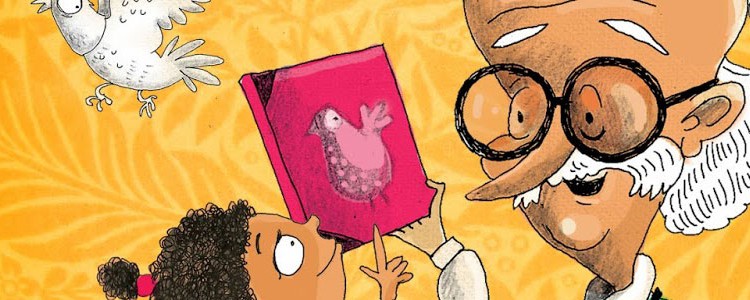Citation by the Jury for the Crossword Award 2013 for Children’s Books
( I was on the jury for the Crossword Book Prize for children’s and young adult literature in 2013. We read over 90+ books to decide the winner. The award was split between two authors — Payal Kapadia and Uma Krishnaswami. Here is the citation read out at the ceremony on 6 Dec 2013 in Mumbai.)
 Citation by the Jury for the Crossword Award 2013 for Children’s Books
Citation by the Jury for the Crossword Award 2013 for Children’s Books
7 December 2013 at 07:46
The Crossword Book Award 2013 for Children’s Books goes to:
Wisha Wozzawriter by Payal Kapadia
And
Book Uncle & Me by Uma Krishnaswami
As seasoned readers who pore through books on a routine basis, it isn’t often that we sit up and gasp and exclaim, WOW! This year while perusing the collection submitted to us by the Crossword team it was the books ‘Wisha Wozzariter‘ & ‘Book Uncle and Me’ that triggered this rare flash of exuberant surprise.
Wisha Wozzawriter
The drudgery, complexity and rigour of creative writing are not exactly the ingredients of a story. Rather than the basis of a storybook, and a children’s book at that, this material belongs squarely in the realm of textbooks. The genius of author Payal Kapadia and her pocket-sized creative writing storybook, Wisha Wozzariter, is the manner in which she has transformed such a drab subject into a wonderful, colourful, absorbing book.
Payal’s book is imaginative, creative and witty. It is one of those uncommon books that work at multiple levels. Unfolding as it does at a captivating pace, it weaves in sentences and references that open up myriad worlds of books and ideas. It is a book that a young reader can enjoy for its wackiness and inventiveness, and constantly return to over the years, growing old with it. Not only is it technically sound but above all it is a good, enjoyable read.
Book Uncle & Me
One of the continuing struggles in Indian writing in English is the quest for a self-confident voice writing in a language given to us by colonialism. Indian children’s books are still finding a voice that reflects our particularities and yet transcends those to speak of universal ideas, a voice that is neither didactic nor exotic, a voice that can both spark the child’s imagination and lead it towards action. Book Uncle and Me is that rare book.
It weaves a simple story in a voice that is strongly rooted in an Indian context and yet speaks of childhood experiences that cross cultural borders. A broken pavement, a library and a girl who has decided to read one book a day come together in an inspirational story about forging a community to create change. Uma Krishnaswami’s skill in experimenting with form by telling the story entirely in free verse is matched with her nuanced understanding of the child’s world. She recognises that children are capable of negotiating complexity in their everyday lives and refuses to talk down to them. Priya Kurien’s illustrations add another layer of resonance, making Book Uncle and Me a truly unforgettable book.
Samina Mishra, Deepak Dalal, Jaya Bhattacharji Rose
12 Feb 2014
UPDATE
I uploaded this note on my Facebook page last week. Since then the authors and other jury members have also commented on the post.I am reproducing their comments below.
Uma Krishnaswami I was unable to make it for the awards ceremony last year, so I missed the reading of the citation. Jaya, I’m getting misty-eyed reading it now. So much of a writer’s life and heart goes into a book, and sometimes (OK, I’ll say it–often) it can seem as if no one is paying any attention at all. I’ll treasure what you had to say about my book. It will bolster me when the writing on the next book gets tough (which it will) or the reviews and sales iffy (things I have no control over). Thank you again to Samina Mishra, Deepak Dalal, and you, Jaya Bhattacharji Rose, for your perfect and instinctive understanding of both intention and craft in Book Uncle and Me.
Samina Mishra Uma, I’m delighted that you think the citation reflects a “perfect and instinctive understanding of both intention and craft in Book Uncle and Me”
Deepak Dalal Speaking about misty eyes, that’s what happens to me when I read great books. ‘Book Uncle & me’ did all kinds of things to my eyes. It was a pleasure and a privilege selecting your book, Uma.
Payal Kapadia Dear Jaya, Deepak and Samina: Wisha had something weighty and worthwhile to say in the face of such a generous tribute! Does a thank-you sufficiently express the gratitude I feel for the warm welcome I’ve received when I’m just the new kid on the block? I was at the awards and I don’t remember the citation being read out — probably because my heart was thumping so fast I could barely think (and still is). Haven’t gotten over the flush of the award, and I’m sure that “the drudgery, complexity and rigor of creative writing” will not appear to be so with your kind words ringing in my ears. I wrote “Wisha Wozzariter” to see if I had it in me to be a writer. Thank you for believing in me — and for showing me that I can take life one book at a time.
Deepak Dalal What a wonderful book, Payal! Deserves all its plaudits and more. Now you have to keep those creative juices flowing…
20 Feb 2014
























